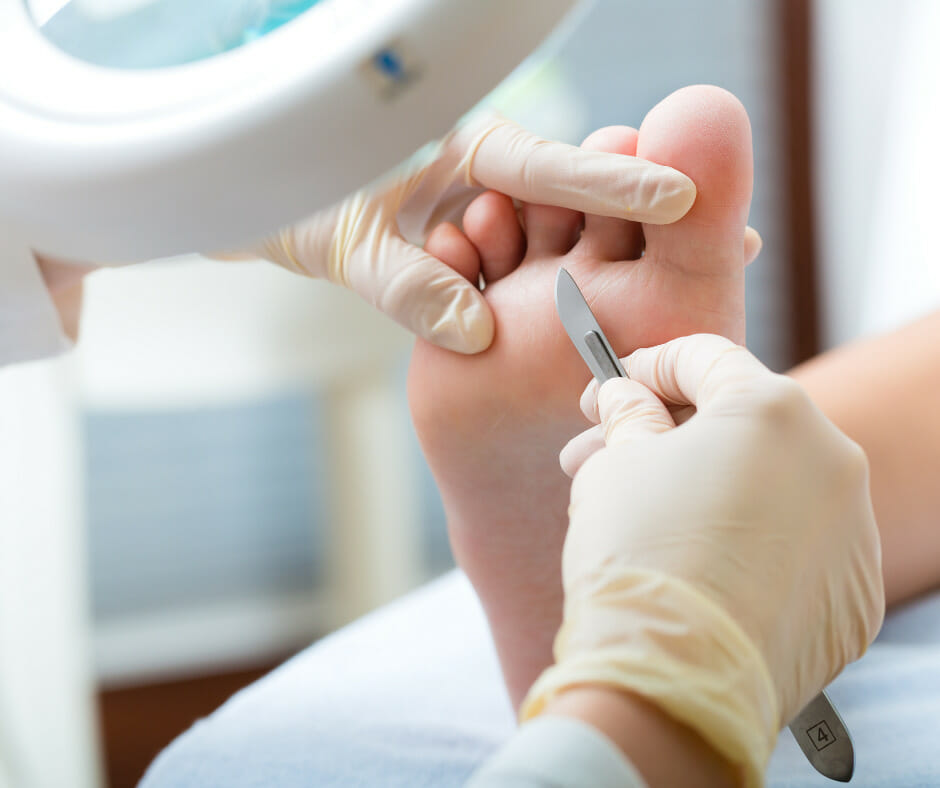The 26 Review
- What are Calluses and Corns? a buildup of hard skin over time due to chronic pressure in a concentrated area
- Causes ill-fitting footwear, hereditary genes, continual foot stress, bone spurs and bone prominences
- Symptoms pain, difficulty walking, difficulty wearing shoes
- Diagnosis physical examination
- Treatment shoe modifications, topical medications, gel pads, on-going professional or self-care, surgery

Let’s take a closer look…
Calluses and Corns are a build-up or collection of hard skin / tissue that develops on or under the foot overtime. Calluses typically develop on the bottom of the feet while corns develop on top of the foot and toes. These can be singular in nature or occur in multiple locations. They can be painful and uncomfortable, especially when they become inflamed or infected, but they can usually be treated easily with some at-home care and relief without having to see a doctor or podiatrist. Calluses and Corns may also be the first visible signs when a larger problem is starting to develop and should not be ignored. Read on to learn more about Calluses and Corns, how to prevent them, how to treat them at home, and potential options on removing them.
Causes
Calluses develop on the bottom and sides of the feet due to chronic or repetitive pressure points. This can be due to a prominent bone under the foot or from a loss of soft tissue such as the plantar fat pad. In individuals who have severe foot deformities such as excessively flat feet, club feet, or amputation sites, abnormal pressure points can develop leading to recurring calluses and problematic skin lesions. Over time, the skin naturally hardens at the site of these pressure points and a callus will develop. Corns usually form when a small, hard deposit of skin develops on top of the foot, typically over the small joints of the toes. Individuals who have developed contractures in their toes, known as Hammertoes, commonly will develop corns over the prominent joints of the toe(s). This repeated pressure and friction, typically from tight or ill-fitting shoes, causes keratin and hard skin deposits to develop in the skin.
Symptoms
If addressed early on, Calluses and Corns are often not serious and can be managed with good self-care and by wearing appropriate shoes. These skin lesions, however, can become bothersome and/or painful over time, especially if neglected. In mild cases without severe pain, the Calluses or Corns can be distracting while you walk because they are felt during everyday activities like running or walking barefoot. This can progress to symptoms of pain and burning in the affected areas and can feel as if you are walking on a rock. These areas of friction and rubbing can progress to blister formation (with or without fluid collection), bleeding, surrounding redness and swelling. In severe cases, Calluses and Corns when ignored can lead to an open wound, such as a diabetic foot ulcer, infection, and unfortunately even amputation. It is important to pay attention to your feet when these lesions develop and seek professional help.
Diagnosis
Clinical presentation interpreted by a physician’s clinical experience and sometimes with the aid of x-ray to rule out other pathology are the primary ways this condition is diagnosed. X-rays will typically demonstrate soft tissue swelling around the affected area of tissue and will determine if there is a prominent bone spur or bone abnormality. X-rays are also used to rule out any associated problems with the nearby bones as the calluses or corns may be an early sign of a larger problem that is starting to develop.
Treatment For Calluses and Corns
Calluses and corns can be removed in several ways depending on their location, and they are not difficult to manage if addressed early on and consistently. A majority of these skin lesions can be addressed with simple shoe modifications combined with topical medications, moisturizing soaks, and proper selfcare tools such as a pumice stone. Be cautious with corn removers sold at drugstores as these can cause worsening problems, especially in those individuals with thin or sensitive skin. When you need a little more help, our licensed master pedicurist offers Waterless Laser Pedicures that can supplement your at-home care.
Another great option to help reduce abnormal callus buildup includes upgrading the inside of your shoes. Over the counter medical grade shoe inserts can be modified by your podiatrist to reduce pressure off plantar calluses, while custom molded orthotics reduce abnormal foot stresses even more precisely. The topical medications and shoe inserts are the simplest and most effective way to alleviate most calluses and corns. In some cases, your podiatrist may facilitate this process in the office by temporarily removing the lesions. When abnormalities are present, such as hammertoes and tight tendons, there are various in-office based procedures such as tendon releases and corn removal procedures that can be very effective in correcting the problems with minimal downtime. When there are large bone deformities, hospital or surgery center-based surgeries may be required for best results. Whatever method you choose, keep in mind that it can take time to get rid of your Calluses or Corns completely.